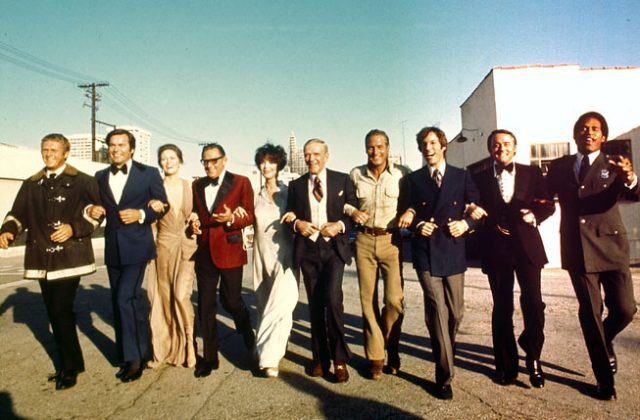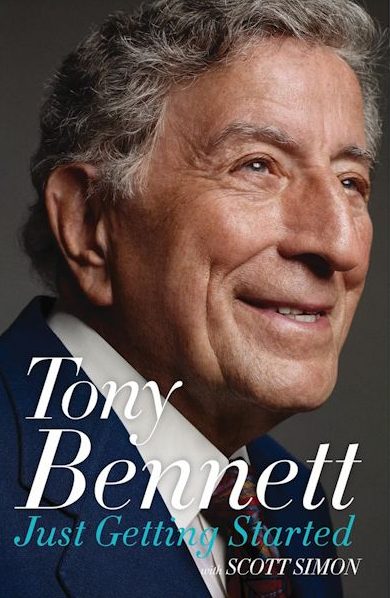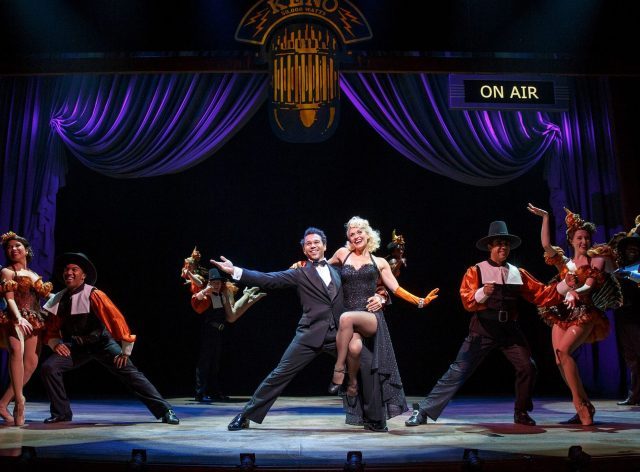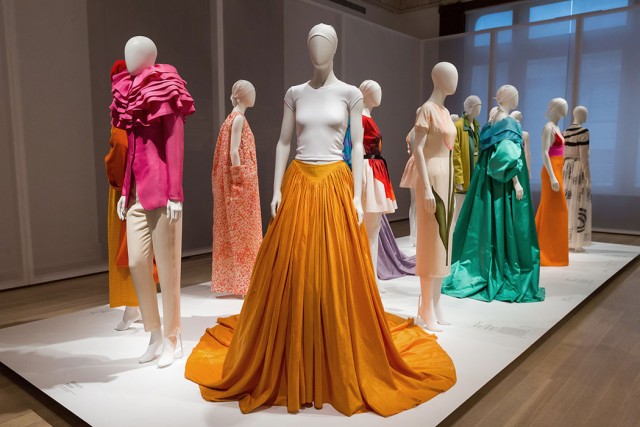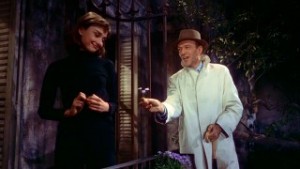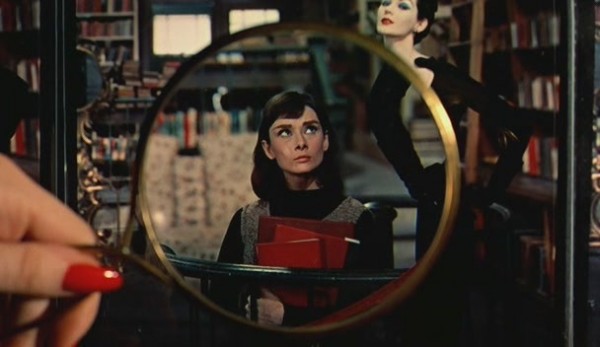
Jo Stockton (Audrey Hepburn) is not happy about fashionistas taking over the bookstore where she works in Funny Face
CinéSalon: FUNNY FACE (Stanley Donen, 1957)
Museum of the Moving Image
35th Ave. at 36th St., Astoria
Saturday, February 23, 4:00, and Sunday, February 24, 6:30
Festival runs through March 10
718-777-6800
www.movingimage.us
 The Museum of the Moving Image’s “See It Big! Costumes by Edith Head” series continues February 23-24 with the “’s wonderful, ’s marvelous” 1957 romantic musical comedy Funny Face. When Quality magazine editor and publisher Maggie Prescott (Kay Thompson) decides she’s after the next big thing, photographer Dick Avery (Fred Astaire playing a fictionalized version of Richard Avedon, who served as a consultant on the film and took the photos) asks, “Are there no models who can think as well as they look?” So they descend on a “sinister” bookstore in Greenwich Village, Embryo Concepts, to show the intellectual side of star model Marion (real-life model Dovima), but instead Dick believes that the bohemian bookstore’s mousy, idealistic sales clerk, Jo Stockton (Audrey Hepburn), might just be exactly what they’re looking for, a fresh face with “character, spirit, and intelligence.” Jo is steadfastly averse to the plan at first, until Dick convinces her that it would be a great opportunity for her to see Paris and go to a lecture by her favorite philosopher, professor Emile Flostre (Michel Auclair), the father of empathicalism. So Maggie, Dick, Jo, and their crew head over to France, where Jo will soon be strutting down the runway in a line specially created for her by superstar designer Paul Duval (Robert Flemyng). But once they get to the City of Lights, everything goes more than a bit haywire as haute couture battles counterculture chic.
The Museum of the Moving Image’s “See It Big! Costumes by Edith Head” series continues February 23-24 with the “’s wonderful, ’s marvelous” 1957 romantic musical comedy Funny Face. When Quality magazine editor and publisher Maggie Prescott (Kay Thompson) decides she’s after the next big thing, photographer Dick Avery (Fred Astaire playing a fictionalized version of Richard Avedon, who served as a consultant on the film and took the photos) asks, “Are there no models who can think as well as they look?” So they descend on a “sinister” bookstore in Greenwich Village, Embryo Concepts, to show the intellectual side of star model Marion (real-life model Dovima), but instead Dick believes that the bohemian bookstore’s mousy, idealistic sales clerk, Jo Stockton (Audrey Hepburn), might just be exactly what they’re looking for, a fresh face with “character, spirit, and intelligence.” Jo is steadfastly averse to the plan at first, until Dick convinces her that it would be a great opportunity for her to see Paris and go to a lecture by her favorite philosopher, professor Emile Flostre (Michel Auclair), the father of empathicalism. So Maggie, Dick, Jo, and their crew head over to France, where Jo will soon be strutting down the runway in a line specially created for her by superstar designer Paul Duval (Robert Flemyng). But once they get to the City of Lights, everything goes more than a bit haywire as haute couture battles counterculture chic.
Partially based on an unproduced show by screenwriter Leonard Gershe called Wedding Bells — which was inspired by the real-life relationship between Avedon and model and actress Doe Nowell — and including four songs from George Gershwin’s 1927 musical, also called Funny Face (and starring Astaire and his sister, Adele), the film is an utter delight from start to finish. Despite an age difference of nearly thirty years, Hepburn and Astaire have genuine chemistry as their characters fall for each other. Unlike 1964’s My Fair Lady, in which Hepburn’s singing voice was dubbed by Marni Nixon, she does all of her own vocalizing in Funny Face, including a lovely solo on “How Long Has This Been Going On?,” and she uses her childhood dance training to fabulous effect in a stunning modern dance scene in a dark and smoky bohemian club. Astaire is a joy as Avery, particularly in the dazzling solo number “Let’s Kiss and Make Up,” performed with hat, raincoat, and umbrella. And Thompson, in her only major film role — she was already in the midst of her four-book children’s series about Eloise, the girl who lives in the Plaza Hotel in New York City — gets things going with the glorious opener “Think Pink!,” her character inspired by Harper’s Bazaar editors Carmel Snow and Diana Vreeland. Among the other songs by George and Ira Gershwin are “On How to Be Lovely,” “He Loves and She Loves,” “Clap Yo’ Hands,” and “Bonjour, Paris!” The costumes, of course, are spectacular, courtesy of Edith Head and Hubert de Givenchy, as are Eugene Loring’s choreography and Stanley Donen’s direction as the story roams around many of Paris’s iconic locations. Everything about the film, which was nominated for four Oscars but came up empty, is fun and fashionable, including cameos by model Suzy Parker; Carole Eastman, who would go on to write Five Easy Pieces and The Fortune; Hepburn’s mother; and a group of girls dressed up like French children’s book favorite Madeline.
Funny Face is screening at MoMI on February 23 at 4:00 and February 24 at 6:30; “See It Big! Costumes by Edith Head” continues through March 10 with such other films as René Clair’s I Married a Witch, Bob Fosse’s Sweet Charity, and Alfred Hitchcock’s To Catch a Thief, The Birds, and Marnie. Head was nominated for thirty-five Academy Awards during her prestigious career, winning the Oscar eight times.
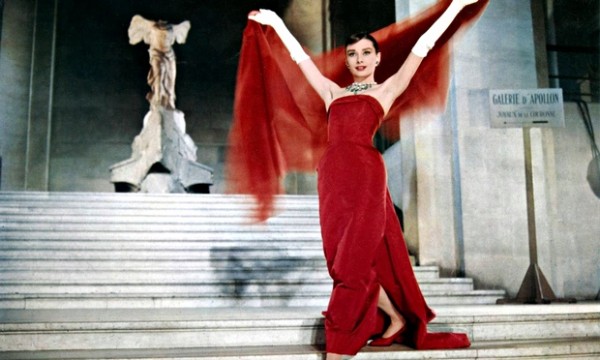
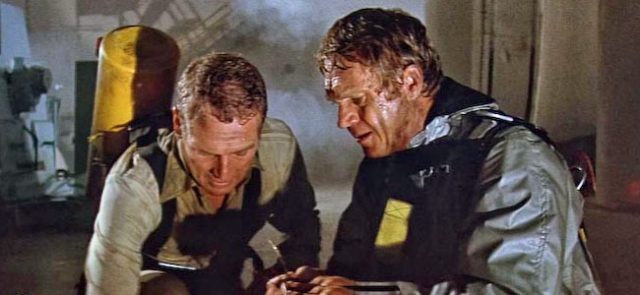
 Disaster flicks were a big thing in the 1970s, and none was bigger than The Towering Inferno. The $14.3 million epic, the first coproduction between two major studios, Warner Bros. and 20th Century-Fox, was based on two novels, Richard Martin Stern’s The Tower and Thomas N. Scortia and Frank M. Robinson’s The Glass Inferno and stars a host of Hollywood greats, led by the dynamic duo of Paul Newman and Steve McQueen. Newman is recently retired architect Doug Roberts, who has come back to San Francisco for the opening-night party celebrating the final building he designed, the 138-story Glass Tower, owned by wealthy businessman James Duncan (William Holden). When a small electrical fire starts in a storage room on the eighty-first floor, Roberts becomes suspicious that Duncan’s son-in-law, smarmy electrical engineer Roger Simmons (Richard Chamberlain), did not follow the specs exactly and cut critical corners. As the fire grows, security chief Harry Jernigan (O. J. Simpson) calls in the fire department, anchored by battalion chief Mike O’Hallorhan (McQueen) and his right-hand man, Kappy (Don Gordon). O’Hallorhan insists that Duncan move the elegant party in the Promenade Room on the 135th floor to the lobby, but by the time Duncan agrees, the flames have spread and escape options become more and more limited — and dangerous. Among the others struggling to survive are con man Harlee Claiborne (Fred Astaire, earning his sole Oscar nomination), his potential target, Lisolette Mueller (Jennifer Jones, in her last performance), U.S. senator Gary Parker (Robert Vaughn), slick public relations man Dan Bigelow (Robert Wagner), his secretary and mistress, Lorrie (Susan Flannery), Duncan’s daughter, Patty Duncan Simmons (Susan Blakely), the deaf Mrs. Allbright (Carol McEvoy) and her two children, Angela (Carlena Gower) and Phillip (The Brady Bunch’s Mike Lookinland), and Roberts’s fiancée, Susan Franklin (Faye Dunaway). Meanwhile, throughout it all, bartender Carlos (Gregory Sierra) remains cool and calm.
Disaster flicks were a big thing in the 1970s, and none was bigger than The Towering Inferno. The $14.3 million epic, the first coproduction between two major studios, Warner Bros. and 20th Century-Fox, was based on two novels, Richard Martin Stern’s The Tower and Thomas N. Scortia and Frank M. Robinson’s The Glass Inferno and stars a host of Hollywood greats, led by the dynamic duo of Paul Newman and Steve McQueen. Newman is recently retired architect Doug Roberts, who has come back to San Francisco for the opening-night party celebrating the final building he designed, the 138-story Glass Tower, owned by wealthy businessman James Duncan (William Holden). When a small electrical fire starts in a storage room on the eighty-first floor, Roberts becomes suspicious that Duncan’s son-in-law, smarmy electrical engineer Roger Simmons (Richard Chamberlain), did not follow the specs exactly and cut critical corners. As the fire grows, security chief Harry Jernigan (O. J. Simpson) calls in the fire department, anchored by battalion chief Mike O’Hallorhan (McQueen) and his right-hand man, Kappy (Don Gordon). O’Hallorhan insists that Duncan move the elegant party in the Promenade Room on the 135th floor to the lobby, but by the time Duncan agrees, the flames have spread and escape options become more and more limited — and dangerous. Among the others struggling to survive are con man Harlee Claiborne (Fred Astaire, earning his sole Oscar nomination), his potential target, Lisolette Mueller (Jennifer Jones, in her last performance), U.S. senator Gary Parker (Robert Vaughn), slick public relations man Dan Bigelow (Robert Wagner), his secretary and mistress, Lorrie (Susan Flannery), Duncan’s daughter, Patty Duncan Simmons (Susan Blakely), the deaf Mrs. Allbright (Carol McEvoy) and her two children, Angela (Carlena Gower) and Phillip (The Brady Bunch’s Mike Lookinland), and Roberts’s fiancée, Susan Franklin (Faye Dunaway). Meanwhile, throughout it all, bartender Carlos (Gregory Sierra) remains cool and calm.